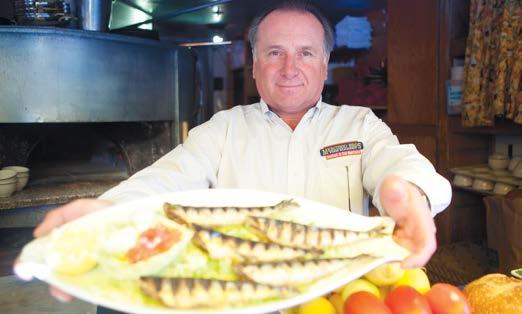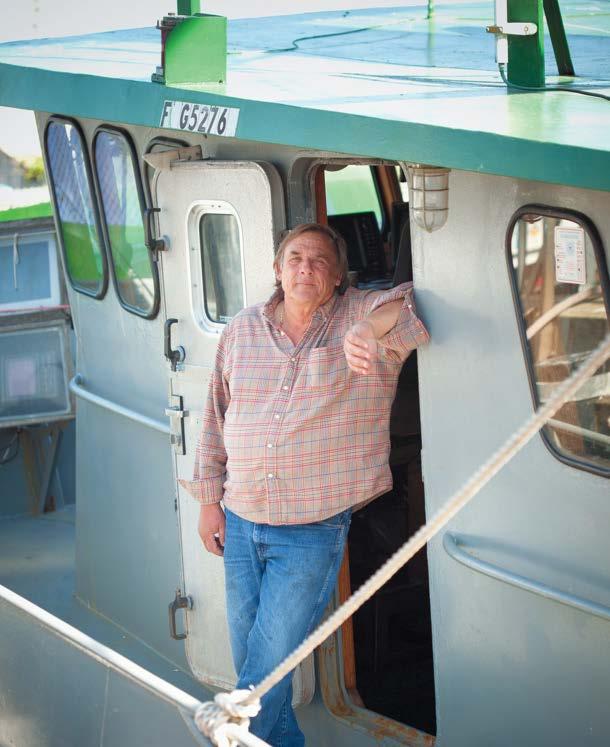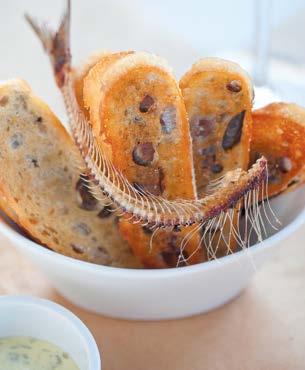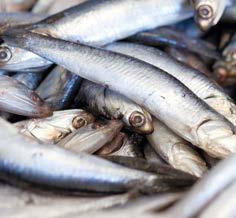
11 minute read
Out to Sea
Out to Sea Fresh Sardines
Catch them while you can
Advertisement
By Lisa Crawford Watson Photography by Patrick Tregenza
Back in the days when Cannery Row was still home to the activity that inspired its name, no one had to ask if the sardines were running. They could smell the sleek fish, hear the syncopated rhythm of sardines carried up conveyor belts and see the steam rising from the canneries.
Up at 701 Wave Street, “The Cafeteria” served lunch in shifts to the workers of some 16 canneries, each releasing their crew to a different tone of the dinner bell so as not to overwhelm the lunch room. Comrades would gather for a cup of coffee and a 10-cent sandwich or for the splurge of another quarter, they could get a hot meal.
In 1968, Hovden was the only remaining cannery. The Cafeteria was replaced by The Sardine Factory, an upscale restaurant whose white-gloved waiters wore tuxedos to serve everything from sardines to steaks. Today, the gloves and tuxedos are gone, but the glamour continues, and sardines are still served when available.
While the canneries are gone now, the sardine fishery eventually reopened. This July, when the summer sardine season starts, the boats will be back out in force. And that’s great news for the increasing numbers of local residents who crave this savory, healthful and inexpensive little fish, because they know that fresh sardines are best.
During the mid-1800s, fishermen and their families came from Asia, then Italy and, eventually, other parts of the world to cultivate a prosperous new life in the Monterey Bay area. They found their future, if not their fortune, in sardines, having understood the oily fish as a vital source of income, as well as a staple in their healthy diet.
What they did not can or crush for fishmeal fertilizer, they consumed—until the sardines stopped swimming, the canneries closed and folks sought other ways to sustain themselves.
Yet the sardines never actually disappeared, says Briana Brady, acting senior environmental scientist for the California Department of Fish and Game (DFG), Marine Region. “Sardines were not endangered,” she says, “but they were no longer in abundance. Sardines go in cycles. Once the abundance came back up, the DFG allowed them to be harvested again.”
In fact, because sardines are small, low on the ocean food chain and quick to mature, they are prized by environmentalists and are considered a “best choice” for sustainability by the Monterey Bay Aquarium’s Seafood Watch program.
This page, Anthony Russo, captain of the King Philip. Opposite, Dominic Mercurio of Café Fina and Domenico’s on the Wharf.

Technically, says Brady, the sardine season is year-round. Yet the fishery year is divided into three periods, each of which lasts only until a designated harvest quota is met, so in practice, the sardine season can be fleeting, and it’s impossible to know in advance how long it will last. The summer season is the biggest. It starts July 1 and permits the harvest of 38,964 metric tons of sardines but runs only until that quota is met, or Sept. 14—whichever comes first. There also are two longer seasons that allow smaller harvests, one beginning January 1 and another, September 15. (The quotas are set
by the Pacific Fishery Management Council and the National Oceanic and Atmospheric Administration (NOAA), and like all fishing quotas, are aimed at protecting against over-fishing.)
The seasons vary from year to year, but your best chance for bringing home fresh local sardines—or finding them on the menu of area restaurants—will come from starting watch for them as soon as the three seasons open, on Jan. 1, July 1 and Sept. 15. In 2009, says Brady, the first season shut down after 40 days, the second after 13 days, and the third season after a mere eight days. The following year, the first season lasted more than six months, but the following two seasons were only 17 and 9 days. Last year, the fishing continued for two months, followed by one week and, finally, just six days, before quotas were reached.
Locally, Whole Foods carries fresh Monterey Bay sardines when they can get them, as does Sea Harvest fish market and restaurant in Monterey and Carmel, Monterey Fish Co. in Monterey, Stagnaro Bros. Seafood Inc. in Santa Cruz and The Fish Lady in Soquel, to name a few.
“Sardines are in high demand,” says The Fish Lady’s Sharon Hadley, whose shop also sells meat, fish, poultry, wine and cheese. “I think people are realizing how good they are and how good they are for you with all those omega 3s. Because their availability is so sporadic, we bring in enough to sell fresh, and then quick freeze and vacuum seal the rest. People buy them right out of the freezer.”
Fresh or frozen, Dominic Mercurio has been eating sardines all of his life. Growing up in a multi-generation Monterey fishing family, Mercurio considers sardines a staple in his diet. His preference is for barbecued sardines, filleted and grilled on an open fire, with salt, pepper and a little cumin. He serves them the same way at Café Fina and Domenico’s on the Wharf, his two restaurants on Fisherman’s Wharf in Monterey.
“Barbecued is preferred,” says Mercurio. “It’s such an oily fish, but it’s the oils that give it intense flavor. It’s a childhood thing. My dad would bring it in off the boat, and we’d sit in the backyard while he grilled it. Asking why I like sardines is like asking a person why he eats caviar. It’s that intense ocean flavor.”

Sea Harvest fish market and restaurant has its own fishing boat, but the crew never knows when it will get sardines—and it finds interest in the fish varies, too. “A lot of people on the Peninsula don’t like the bones in sardines,” says Dimas Lopez, manager of Sea Harvest Monterey. “They want a filleted fish; everybody is in a hurry. Dimas says most sardines are sold overseas or in Chinatown, but the store’s Portuguese, Italian and French customers look for whole sardines.
Monterey Fish Co., whose patrons are best directed to their market on the wharf by the sound of barking seals and the fragrance of fresh fish, has been riding a swell of interest in sardines coming from both restaurants and consumers.
“The Europeans who come to town are used to sardines, and a lot more Americans are starting to catch on to the health benefits of the fish, as well as their good taste,” says Sal Tringali, whose company offers sardines at about $1 a pound. “We sell a lot of sardines to the local restaurants, as more and more seem to be putting sardines on the menu. When the season begins, fishermen stop what they’re doing and go fishing for sardines. But once the quota is filled, the season is closed, and we all wait until the next period.”
Anthony Russo, captain of the King Philip, one of the biggest fishing boats on the Monterey Bay, he says, has been fishing for sardines some 45 years.
“I’m the guy who’s catching them,” says Russo. “I think, because it’s a smaller fish that doesn’t take on much mercury or other pollutants, and because it is a healthy fish with all those heart-healthy omega 3s, plus its wonderful storied history, the sardine is making a comeback in the waters and at the table.
“When we talk sardines, we don’t mean those teeny fish from Norway you eat with crackers. Ours are bigger, but they’re still oily, with a lot of bones, which doesn’t appeal to everyone. They’re kind of like tuna. The public doesn’t know about sardines because they haven’t been marketed by StarKist’s brainchild ‘Charlie the Tuna.’ But I’ll tell you, unlike tuna, which is very bland—people don’t realize with a tuna sandwich they’re enjoying the mayonnaise and celery—sardines are flavorful. If you prepare them right, they’re good and good for you.”
Shape magazine’s Jessica Smith reports that the fish is full of fat-fighting compounds that help stabilize blood sugar. She notes they are also rich sources of CO enzyme Q10, vitamin B12, selenium, calcium, phosphorus and vitamin D, and yes, those omega-3 fatty acids that everyone is focused on. They are also satiating, packed with protein, and all in all she considers sardines superb diet food— unless, of course, you slip the filleted fish on a toast point slathered in some kind of aioli sauce. Then the sardine diet slips off the scale.
The DFG’s Brady says she really enjoys fresh sardines, particularly grilled, but also admits to dropping by Whole Foods for canned sardines packed in oil, which she serves on crackers.
Sardine dishes are becoming increasingly popular menu items at several area restaurants, including Oswald in Santa Cruz, where Chef Damani Thomas prefers them pickled. “This is my take on a Spanish dish called Escabeche, served with carrots, capers and some shallots,” says Chef Thomas. “To pickle the sardines, I usually use a sweet vinegar, like balsamic or apple cider vinegar. It’s just incredible. I filet and lightly flour the fish, and then sauté it quickly on the skin side to crisp

Serves 3 to 4
Courtesy Brendan Jones, co-owner and chef at Carmel Valley’s Lokal, and also a chef at the Cachagua General Store, the Carmel Valley restaurant where he originated this recipe.

I’d say 80% of people are terrified of sardines and the other 20% love them—it’s a fear-factor type of thing. Once we get people to have them, they like them—most love them. People think they’re fishy, but fresh sardines aren’t fishy at all. It’s a great fish—it’s small, it’s low in mercury…the best part is they’re cheap as hell. —Brendan Jones
10 fresh or frozen whole sardines 1 sourdough baguette 1 lime, juiced 1 cup fresh mint leaves 4 egg yolks 12 ounces canola or neutral-flavored oil 1 teaspoon salt 2 ounces olive oil
Tools: Sharp knife, 1-quart round container, griddle, immersion blender with whisk and chopping attachments
For the sardines: Put sardines in a container of cold water. De-scale sardines in water, pat dry with paper towel, cut down either side of spine to fillet. Put fillets aside, keep cool.
For baguettes: Cut bread into angled slices as thin as possible at the average length of fillets. Prepare twice as many pieces as you have sardines, so 20 slices for 10 sardines.
For mojito aioli: Put mint, yolks, lime juice and salt in 1-quart round container. With immersion blender and chopping attachment, blend until mint has been chopped into small pieces. Next, attach whisk and whisk mixture at an angle, drizzling in the canola oil very slowly until all canola has been emulsified into mixture. (It helps to have a second person hold the container for you.) Taste. Add more salt or lime juice as needed. If mix is too hard, you can mix in a couple tablespoons of warm water. Keep cool.
Make sandwiches from the bread and fillets, and place on flat cool plate or tray. Brush both top and bottom of each sandwich with olive oil. Do not be shy with olive oil. Once griddle is at 375° F, place a couple sandwiches on griddle. Cook each side of sandwich until golden brown. Make sure you press down on sandwiches while cooking, so the protein binds to the bread, causing the sandwiches to stick together.
Put on plate and serve aioli as a dipping sauce.
it up a bit. The pickling liquid gets poured warm over the sardine, and then it sits for 24 hours. Served with a little watercress salad, it’s just delightful. It’s labor intensive but so tasty, it’s worth it.”
Other local favorites include sardine sushi served at Crystal Fish in Monterey, and the Sardine Bocadillos with Mojito Aioli, offered at both the Cachagua General Store and Lokal, in Carmel Valley. (See recipe opposite.) If you’re not already hooked on sardines, beware: These restaurants just might make them a heart-healthy habit.
Lisa Crawford Watson lives with her family on the Monterey Peninsula, where she is a freelance writer and an instructor of writing and journalism for California State University Monterey Bay and Monterey Peninsula College.
Editor’s note: As this issue of EMB went to press, sardines were a hot topic at Cooking for Solutions at the Monterey Bay Aquarium. Search for coverage on our blog by typing “sardines” into the “search” box on our home page.

Fresh Grilled Sardines with Salsa
Courtesy Dominic Mercurio, owner of Café Fina and Domenico’s on the Wharf, Monterey
Chopped tomatoes Red wine vinegar Chopped fresh garlic Oregano Lemon juice Olive oil Salt, pepper and cumin Fresh sardines
Combine first six ingredients. Fillet sardines and grill on an open fire with salt, pepper and a little cumin. Serve with salsa.










